|
|
Mountain/Rock |
|---|---|
|
|
27.91991°N / 86.76616°E |
|
|
Mountaineering |
|
|
21129 ft / 6440 m |
|
|
Overview
Cholatse is a stunning peak with narrow snow and ice ridges and steep faces. It is on the ridge separating the Gokyo and Khumbu valleys, just north of Taboche and just south of a 5420 meter pass used by Sherpas and trekkers alike to go between the Gokyo and Khumbu valleys. Interestingly, there is a lake just below this pass to the east, and in Tibetan 'cho' is lake, 'la' is pass, and 'tse' is peak so Cholatse means literally "lake pass peak".
It is one of the more prominent peaks on the approach to the Mt. Everest Basecamp. Although it does not have quite the commanding position of Ama Dablam, it is prominent as people ascend above Pheriche all the way to base camp, with beautiful views possible in the region of Lobuche. Athough not seen by as many people, the views of it from the Gokyo valley are also stunning. Due to its proximity to the viewer, the peak dominates the scene if you are ever fortunate enough to view a sunset from the summit of Gokyo Ri.
Unlike many mountains, there is no easy way to reach or descend from its summit, so any climb of the mountain is a serious mountaineering undertaking. Through the 1950's 60's and 70's, Everest, Ama Dablam and the other named peaks of the Khumbu were climbed one by one but no permits were granted for Cholatse, so it remained unclimbed until 1982 when it was infact the last named but unclimbed peak in the Khumbu. In that year, Al Read from Mountain Travel secured a permit for the peak. In April of that year, Vern Clevenger, John Roskelley, Galen Rowell and Bill O'Connor reached the summit via the South West Ridge. The climb was described as some twenty pitches of difficult ice climbing.
Later that same year, a Swiss expedition with Heidi Ludi, Niklause Alpiger and the Nepelese climber Kancha Tamang reached the summit after fixing ropes on much of the South East Ridge. The following year, the startling North East face was climbed by Todd Bibler, Catherine Freer, Penny Jackson and Sandy Stewart. At a slide show, Bibler, who had waltzed up the Eiger's North Face on an earlier European trip implied that the climb was quite scary (VI AI5 5.9 A2). It wasn't until many years later that Tomaz Humar, Aleš Koželj and Janko Oprešnik made the 2nd ascent of the NE face of Cholatse with a new variation on 23 April 2005. Several additional lines have been climbed including the prominent Western Rib of the West Face and the long corniced North West Ridge.
During 2005 a number of variations of the North-East and North Face climbs were achieved including the first Winter Ascent of the North Face by the Koreans Park Jung-hun and Choi Kang-sik who were unfortunately both significantly injured by frostbite following an accident on the descent from the summit. Ueli Steck made a solo ascent of the north face including a direct finish in a 37 hour push from base camp with a single bivouac on the face. He reports the difficulty as "rock to F5, ice to 90 degrees, and M6 terrain noting the climb was similar in difficulty to the north face of the Eiger. He was named as one of Europe's three best alpinists by "Climb!" magazine as a result of this climb and that of neighboring Tawoche.
The number of climbs has accelerated in recent years. The North, and North-East Face routes have become test pieces for mountaineers wanting to challenge themselves on a beautiful and fairly accessible peak. In addition, the peak has started to see a few commercial expeditions coming to it in recent years, with most following the South-West Ridge, a route that wasn't repeated until 1993, and then again in 2005. It has been called both harder and much less crowded than the standard route on Ama Dablam.
Getting There
Generally people intending to climb Cholatse fly to Kathmandu where additional supplies and food can be picked up, permits dealt with, and several days of sightseeing can easily fill several days.
Cholatse itself is between the Khumbu and Gokyo valleys, so which valley you go up depends upon the route intended. Some of the routes from the Khumbu side are extreme, while the Gokyo side offers a couple more moderate options. I will describe a possible itinerary to reach the western base camp because that is the one I am more familiar with.
Day 1: Fly to Lukla, walk up the Dudh Kosi gorge for a few hours that afternoon. One observation we found was not to filter the river water as the silt quickly clogs the filter. Use water from a clearer tributary instead.
Day 2: Continue up the gorge, crossing the river a couple times. Eventually, climb a steep hill with the first possible views to Mt. Everest. Finish the day in Namche Bazar. (I am using spellings in the upper towns here as written in the Khumbu Himal 1:50.000 map referenced below.)
Days 3 and 4: Acclimate in Namche. There are some spectacular early morning views of Mt. Everest from the slopes surrounding town. Often by mid morning mists obscure the views, though.
Day 5: Leave Namche on the trail to Mt. Everest. If you are climbing a route on the Eastern or Northern side of the peak you will continue on this trail for several days towards the town of Pheriche. If you are climbing a western route, near the town of Khumjung, take the trail that climbs steeply up and over a 3973 meter shoulder of Khumbui Yul Lha then descends steeply to the small hamlet of Phortse Drangka. There are spectacular views of Ama Dablam this day if the weather is clear.
Day 6: Climb steeply up and out of the trees and lush fields into the higher alpine zone around Dole. Continue along a more level path to Machhermo to spend the night. Legend has it that in the early 1970's, yeti came down into this town and attacked a couple yak, so be on the lookout for this elusive creature. There are also spectacular views of Kyajo Ri on the west side of the valley and the first views of Cholatse to the east side if the weather is clear.
Day 7: Continue up the valley, but instead of going toward Gokyo, take a spur path across the river to Na. From here, work up first trails then open slopes to reach the base camp in the flat fields of the valley above Ganglha. The base camp is on the left side of the valley right where an old lateral moraine dips down into the flat valley floor. This is a beautiful place with clear running water and a spectacular view of Cholatse, the surrounding peaks and a row of sharp spires on the ridge just to the north.
If you are desiring one of the North Face approaches, on day 5, after reaching the vicinity of Khumjung, continue up the Khumbu Valley instead of turning left towards Gokyo. At Sanasa, turn right and descend down to cross the Dudh Kosi River before ascending steeply to Tengboche where there is a famous monastery. On day 6, continue up the Khumbu Valley, leaving the trees behind and arriving at the wind swept town of Pheriche. After possibly acclimating here for a day (there are some beautiful hikes on the surrounding hillsides), continue up the Khumbu Valley to the steep rise up towards the small village of Dughla. Instead of going in this direction, follow trails up the side valley in the direction of Cho La, setting up a base camp in an appropriate place for the route desired. There is a beautiful lake here to enjoy as you acclimate.
There are a couple other options for approach. There is an airstrip above Namche that some use. This would cut out a day or two of approach but you would want to add the time in acclimating anyways. A third option, and one often used for the bulk of the supplies and equipment is to take a vehicle to Jiri and then walk in through the beautiful Nepalese hill country, over a series of high passes and deep lush valleys to reach Namche. This is a spectacular hike and well worth considering for either going into or coming out of the mountains.
Red Tape
For many years, permits were not offered for Cholatse. The well known American climber Lute Jerstad tried repeatedly to get one from the Nepalese government without success. Once the peak was opened to climbing in the early 1980's it was an expedition peak. However, recently, the mountain has been reclassified as one of the trekking peaks making access and the administrative aspect of an ascent easier. Information about the trekking peaks as well as a great photo of Cholatse can be found here. SummitPost has this website on trekking peaks. Currently, the permit costs $500 for the first seven people and $100 for each additional member up to a total of 12 people.
There is a Rs3000 fee required to enter into Sagamartha National Park that is payable at the entry point in Mongo. You are also required to show your passport at this point. There is further information on this and other Nepalese parks here. There is also a $250 fee for garbage removal. This fee is refunded at the end of the trip if the sirdar and trip members sign off that the base camp site in a clean state.
In the early 2000's there were reported there were Maoist rebels active in the mountains of Nepal. Although they did not generally attack tourists, trekkers, or mountaineers, there were instances when climbers were held at gunpoint and required to pay a fee in order to continue their expedition. The situation has stabilized, though, and I have heard of no such instances in recent years.
Camping
There are many excellent tea houses on the approach through the hill country and in the villages in the higher mountains. Many of these serve excellent Dhal Bat for meals, and a comfortable lodging for the night.
The base camp on the Western (Gokyo) side of the mountain is in a beautiful, flat alpine field with fresh water and spectacular scenery. There is abundant terrain for tents. This site is at about 4750 meters in the valley immediately west of the peak. This is reached by going up the Gokyo Valley on the west side of the river as described above.
Weather
Mountain-forecast.com provides a forecast for the weather on Cholatse. It can be accessed here.
External Links
An excellent map is: Khumbu Himal 1:50.000 Nepal-Kartenwerk der Arbeitsgemeinschaft fur vergleichende Hochgebirgsforschung Nr. 2 1965 revised 1988. On this map, the peak is written as 'Jobo Lhaptshan'
The first ascent of Cholatse was described by Galen Rowell in the 1983 American Alpine Journal (vol. 25) pgs. 15 - 21. This same edition has a shorter piece on the Swiss ascent of the South East Ridge on page 231. A link to much of this can be found here.
Exploration of the West side of Cholatse including the first ascents of the West Rib and the North West Ridges can be found in the American Alpine Journal, 1989 (vol. 31) pgs. 39 - 44. This was written by Andy Selters.
Mountain INFO High Magazine (138) May 1994 describes ascents that had taken place up to that point on Cholatse starting on Pg. 8.
John Climaco wrote a brief description (with a fabulous photo) of our 1993 ascent of the mountain in the 1994 American Alpine Journal and Andrew Brash added his comments on this web page.
A description of the ascent of the North Face is provided in: The American Alpine Journal 1996 pg. 281. It is written by Paul Robach and includes a picture of the upper portion of the route.
A second attempt on the North Face is described by Peter Jensen-Choi in the 2004 American Alpine Journal pg. 401. It includes a picture of the earlier route and one of their attempted line.
Extensive information on North Face ascents can be found in the 2006 American Alpine Journal. There were a number of new variations put up on both the North and North-East face during 2005, including the first Winter ascent of the face. Photographs with route lines are included. See pages 54 - 56 for a description of a solo ascent (the author claims this to be the 1st solo ascent which is arguable given that others have summitted the peak solo as part of larger expeditions) Also see pages 417 - 422 for accounts of numerous climbs on the northern side of the peak, as well as an attempted winter ascent of the South West Ridge.
There is a short article on a 2010 ascent of a new line on the north face of Cholatse here, and a descripton of a 2009 ascent here.
Some nice photos of a climb if the South Rib can be found in Stephen Venables and Andy Fanshawe, Himalaya Alpine-Style, Mountaineers Books, 1996. However, it is worth noting that Canrad Anker reported that this line did not look safe at this point due to the melting of ice on the peak.
Panorama from the Summit. This link give a 360 degree panorama from the summit of Cholatse. I'm not sure who took the video. It's grainy but interesting never the less. The summit has changed since 1993.
Movie of Cholatse Ascent
The 2005 expedition to the S.W. Ridge of Cholatse made an outstanding movie, Light of the Himalaya, of both their climb of Cholatse and work by the team to fix cataracts in the Nepalese people. The film has won multiple awards and shows detailed pictures of the South West Ridge Route to the summit of the Peak. It can be purchased herehere for about $30. Sixty percent of the money goes directly into the foundation that works on curing cataracts. By buying this movie you will be donating enough money to more than cure a person from blindness.
Videos:
Ueli Steck and Freddie Wilkinson climbing the North Face
Longer version of the Ueli Steck and Freddie Wilkinson ascent
Some nice views from below by "focusdevil1"
Commercial Expeditions
In recent years, several companies have begun to offer trips climbing Cholatse. Below is a selection. I have no experience with these companies, so their presence here is not an endorsement.
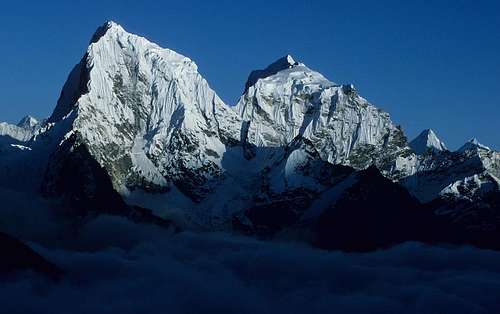
This is a view of the West Face of Cholatse (left) and Taboche from the summit of Gokyo Ri. The photo was taken in 1993.
Thanks
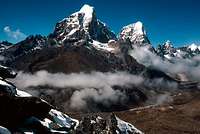
Cholatse is the peak to the right of center. This photo was taken from the slopes of Ama Dablam by Nelson. The peak in the center is Taboche.
I would like to thank Andrew Brash for generously providing pictures from the 1993 ascent of Cholatse. His images bring life to the page. Thank you also, Greg Sievers for your great photos from 2004 also thanks, raj96290, fdoctor, Nelson, and William Marler for graciously allowing me to include your images on this site. Finally, thanks to dmiki for contributing numerous improvements to the page.



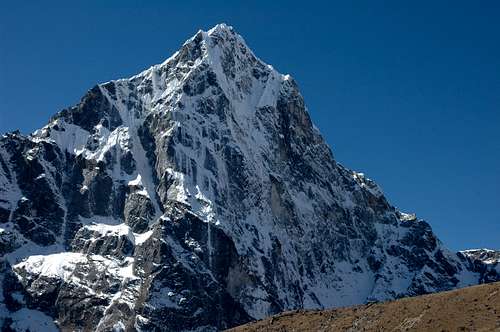
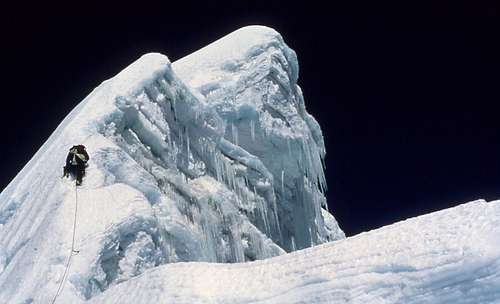
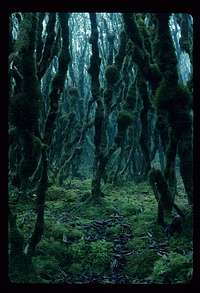


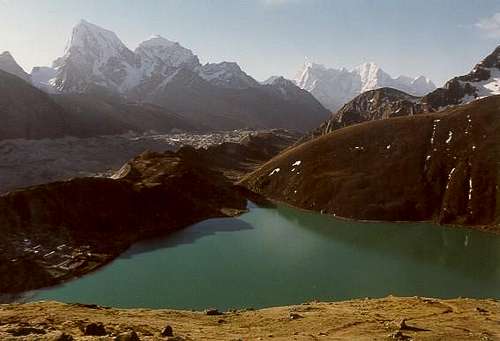
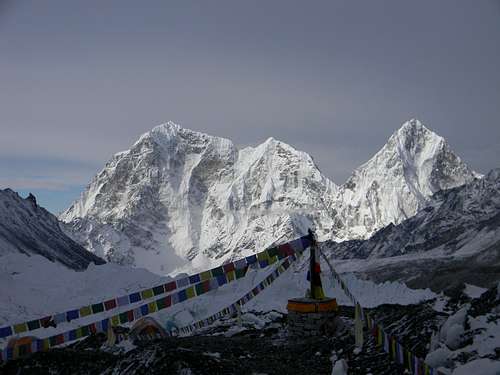

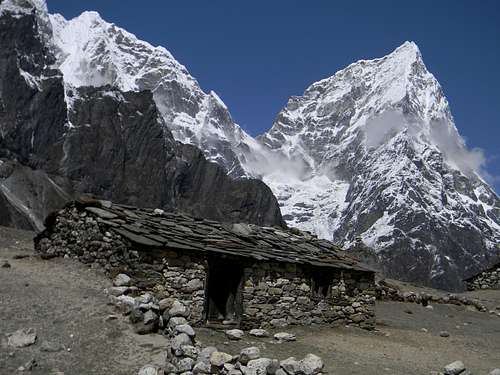
dmiki - Nov 27, 2010 4:35 am - Voted 10/10
ascentsTomaz Humar, Aleš Koželj and Janko Oprešnik made the 2nd ascent of the NE face of Cholatse with a new variation on 23 April 2005. The photos that you linked (http://gallery.cuk.nu/cholatse/cholatse_6440m) are probably from this trip. For his 2005 ascent of Cholatse (and Tawoche), the climbing magazine "Climb!" named Ueli Steck one of the three best alpinists in Europe.
dmiki - Dec 24, 2010 8:51 am - Voted 10/10
Weather forecast (not sure how reliable)http://www.mountain-forecast.com/peaks/Cholatse
everesthiker - Jan 19, 2019 9:54 am - Hasn't voted
cholaste peak climbingthank you for providing great article we love it http://exploremanaslu.com/ http://everesthiker.com/ Please write more blog for us
RobSC - Jan 19, 2019 5:28 pm - Hasn't voted
Re: cholaste peak climbingThank yo for your kind words. This was probably the best mountaineering expedition that I ever went on.
lscritch2 - Apr 23, 2019 2:03 pm - Hasn't voted
misspelled nameIt's Renny Jackson not Penny Jackson.